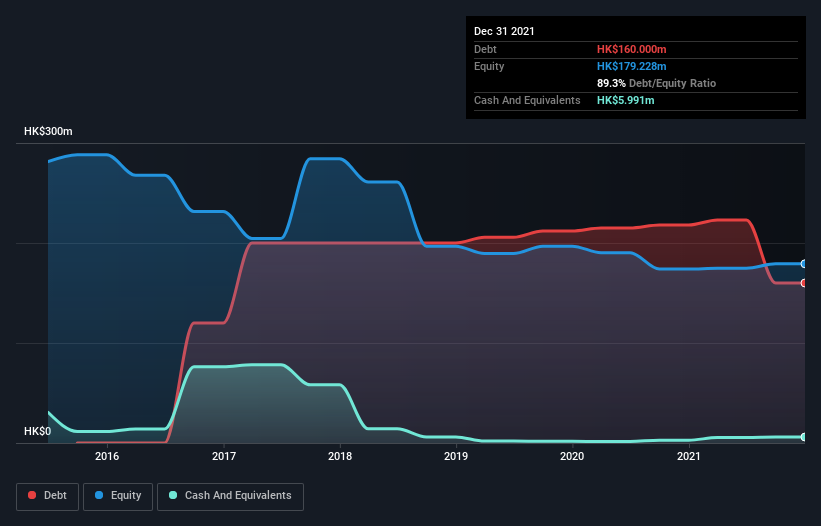- Hong Kong
- /
- Real Estate
- /
- SEHK:63
Here's Why China Asia Valley Group (HKG:63) Is Weighed Down By Its Debt Load

David Iben put it well when he said, 'Volatility is not a risk we care about. What we care about is avoiding the permanent loss of capital.' When we think about how risky a company is, we always like to look at its use of debt, since debt overload can lead to ruin. We can see that China Asia Valley Group Limited (HKG:63) does use debt in its business. But is this debt a concern to shareholders?
When Is Debt Dangerous?
Debt and other liabilities become risky for a business when it cannot easily fulfill those obligations, either with free cash flow or by raising capital at an attractive price. In the worst case scenario, a company can go bankrupt if it cannot pay its creditors. However, a more usual (but still expensive) situation is where a company must dilute shareholders at a cheap share price simply to get debt under control. Of course, debt can be an important tool in businesses, particularly capital heavy businesses. When we think about a company's use of debt, we first look at cash and debt together.
Check out our latest analysis for China Asia Valley Group
What Is China Asia Valley Group's Debt?
The image below, which you can click on for greater detail, shows that China Asia Valley Group had debt of HK$160.0m at the end of December 2021, a reduction from HK$218.0m over a year. On the flip side, it has HK$5.99m in cash leading to net debt of about HK$154.0m.

How Healthy Is China Asia Valley Group's Balance Sheet?
According to the last reported balance sheet, China Asia Valley Group had liabilities of HK$244.2m due within 12 months, and liabilities of HK$184.0k due beyond 12 months. Offsetting this, it had HK$5.99m in cash and HK$9.36m in receivables that were due within 12 months. So it has liabilities totalling HK$229.1m more than its cash and near-term receivables, combined.
Given this deficit is actually higher than the company's market capitalization of HK$177.6m, we think shareholders really should watch China Asia Valley Group's debt levels, like a parent watching their child ride a bike for the first time. Hypothetically, extremely heavy dilution would be required if the company were forced to pay down its liabilities by raising capital at the current share price.
In order to size up a company's debt relative to its earnings, we calculate its net debt divided by its earnings before interest, tax, depreciation, and amortization (EBITDA) and its earnings before interest and tax (EBIT) divided by its interest expense (its interest cover). This way, we consider both the absolute quantum of the debt, as well as the interest rates paid on it.
Weak interest cover of 0.90 times and a disturbingly high net debt to EBITDA ratio of 36.1 hit our confidence in China Asia Valley Group like a one-two punch to the gut. This means we'd consider it to have a heavy debt load. One redeeming factor for China Asia Valley Group is that it turned last year's EBIT loss into a gain of HK$3.1m, over the last twelve months. The balance sheet is clearly the area to focus on when you are analysing debt. But it is China Asia Valley Group's earnings that will influence how the balance sheet holds up in the future. So if you're keen to discover more about its earnings, it might be worth checking out this graph of its long term earnings trend.
Finally, while the tax-man may adore accounting profits, lenders only accept cold hard cash. So it's worth checking how much of the earnings before interest and tax (EBIT) is backed by free cash flow. Over the last year, China Asia Valley Group recorded negative free cash flow, in total. Debt is usually more expensive, and almost always more risky in the hands of a company with negative free cash flow. Shareholders ought to hope for an improvement.
Our View
To be frank both China Asia Valley Group's net debt to EBITDA and its track record of covering its interest expense with its EBIT make us rather uncomfortable with its debt levels. But at least its EBIT growth rate is not so bad. Taking into account all the aforementioned factors, it looks like China Asia Valley Group has too much debt. That sort of riskiness is ok for some, but it certainly doesn't float our boat. The balance sheet is clearly the area to focus on when you are analysing debt. But ultimately, every company can contain risks that exist outside of the balance sheet. Case in point: We've spotted 3 warning signs for China Asia Valley Group you should be aware of.
If, after all that, you're more interested in a fast growing company with a rock-solid balance sheet, then check out our list of net cash growth stocks without delay.
If you're looking to trade China Asia Valley Group, open an account with the lowest-cost platform trusted by professionals, Interactive Brokers.
With clients in over 200 countries and territories, and access to 160 markets, IBKR lets you trade stocks, options, futures, forex, bonds and funds from a single integrated account.
Enjoy no hidden fees, no account minimums, and FX conversion rates as low as 0.03%, far better than what most brokers offer.
Sponsored ContentNew: AI Stock Screener & Alerts
Our new AI Stock Screener scans the market every day to uncover opportunities.
• Dividend Powerhouses (3%+ Yield)
• Undervalued Small Caps with Insider Buying
• High growth Tech and AI Companies
Or build your own from over 50 metrics.
Have feedback on this article? Concerned about the content? Get in touch with us directly. Alternatively, email editorial-team (at) simplywallst.com.
This article by Simply Wall St is general in nature. We provide commentary based on historical data and analyst forecasts only using an unbiased methodology and our articles are not intended to be financial advice. It does not constitute a recommendation to buy or sell any stock, and does not take account of your objectives, or your financial situation. We aim to bring you long-term focused analysis driven by fundamental data. Note that our analysis may not factor in the latest price-sensitive company announcements or qualitative material. Simply Wall St has no position in any stocks mentioned.
About SEHK:63
China Asia Valley Group
An investment holding company, engages in property management business in Japan and the People’s Republic of China.
Slight with acceptable track record.
Similar Companies
Market Insights
Community Narratives



